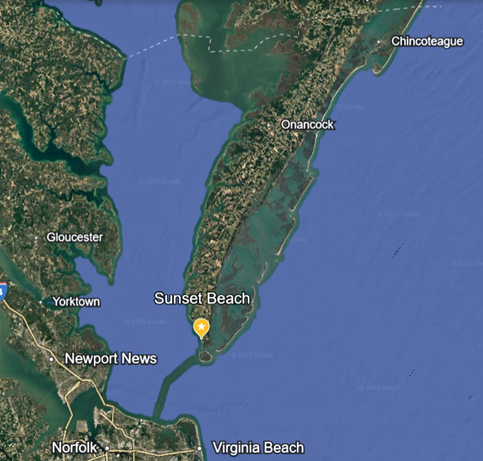My name is Baxter Beamer, and I am thrilled to be joining CVWO this fall as the Morning Flight Project Specialist! I will begin this blog post by briefly introducing myself, and will then provide some background for this new CVWO migration count I will be running this fall.
I am from Charlottesville, Virginia and started birding there ten years ago with a cohort of other young birders in the Blue Ridge Young Birders Club. My interest in birds has led me to pursue a career in ornithology and conservation, and I have recently graduated from Virginia Tech where I majored in Wildlife Conservation. My interests as a birder include furthering knowledge of bird status and distribution, learning how to identify challenging groups of birds, visible migration, and photography. Morning flight is at the nexus of all these interests, and I couldn’t be more excited to spend this fall on the Eastern Shore!
Now on to the
good stuff. Before introducing this count, I will provide some background on morning flight for anyone unfamiliar with this unique migratory behavior.
First,
imagine yourself as a birder primed to witness an incredible morning flight in
Virginia. It is late September, just before dawn, and you are standing at
Sunset Beach, overlooking the Chesapeake Bay to the west. The weather shifted
last night; the first chilly breeze of fall was in the air, and the wind
direction was out of the northwest: perfect conditions for a big flight of
migratory birds. Maybe you heard some migrants giving flight calls last night
as they winged their way through the dark sky, riding the cold front on their
journey south.
Now it is morning, and the sun is about to rise. Suddenly the air begins to come alive as small groups of songbirds launch out of the trees to your south, crossing overhead as they move north along the shore of the bay. As the morning draws on the flight intensifies, and you can barely keep up as hundreds of migrants turn into thousands, all passing after just a few seconds in view. Many of the birds are warblers, but vireos, tanagers, grosbeaks woodpeckers, and a multitude of other species are moving too. Waves of birds stream north throughout the morning, until the flight gradually subsides after a few action-packed hours of jaw-dropping spectacle. You have just witnessed an incredible morning flight!
Northern Parula flying north past Sunset Beach during morning flight, September 8, 2024
If morning
flight is something you are not familiar with, certain elements of this
description may sound a little counterintuitive. Why are species that
were migrating south all night during fall migration turning around and going
back north in the morning, and why does it happen here on the Eastern Shore?
The answers to
the above questions are still being investigated, and morning flight is still a
relatively new field of study in migration research. But studies using data
from migration counts like this one combined with weather data and radar have have provided some answers as to what is happening with
morning flight.
In a nutshell, morning flight is understood to be a behavior to “correct course” during migration, typically exhibited by nocturnal migrant songbirds after a night of migration. During fall on the East Coast, this behavior is typically associated with certain weather conditions. Winds out of the northwest, often accompanying autumn cold fronts, provide a tailwind for many birds to use as they make their way south across the continent. Despite their benefits as a tailwind, strong northwesterly winds tend to displace a large number of migrants in eastern North America well east of their intended flight path. This displacement is called wind drift.
Many of these migrating birds thus find themselves in a perilous situation after experiencing wind drift: They are much closer to the coast than they intended, or even worse, find themselves flying out over the open water of the Chesapeake Bay or Atlantic Ocean as the sun rises. Flying over open water during the day is a dangerous energy expenditure for a nocturnal migrant that would much rather be refueling or resting in a habitat with cover.
Migrating
songbirds want to avoid the situation of this Wilson’s Warbler , which was spotted flying
over a group of birders on a pelagic trip 70 miles off the coast of Virginia
Beach! September 7, 2024
Morning flight is generally thought to be an important way for birds to correct for wind drift and avoid further travel complications. It may also be exhibited by birds selecting foraging habitats in the early morning. The narrow, funnel-shaped peninsula of the Eastern Shore acts as a natural concentration point for migrants, waterlocked to the west and south by the Chesapeake Bay, and to the east by the Atlantic Ocean. Surrounded by water, migrants concentrate at the tip of the peninsula and correct course, sending them straight past Sunset Beach as they turn north to look for somewhere on the peninsula to forage.
A map of Virginia’s Eastern Shore showing Sunset Beach’s position at the southernmost tip of the peninsula
Birders have long known of the incredible morning flight spectacles that occur at Sunset Beach, but this fall will be the first time a daily count is conducted using standardized data collection protocols. CVWO will be joining other ongoing morning flight counts elsewhere around the world documenting this unique migratory behavior.
Documenting the volume and species composition of birds engaging in morning flight throughout the fall is the primary goal of this project. This data will also inform habitat management decisions to support the diversity of migrant species moving through the Eastern Shore and will help further our understanding of the varying factors influencing morning flight behavior.
Starting August 1st, I will be counting migrating birds every morning at Sunset Beach through November 15th. Counts will start just before sunrise and last until the flight has ended for the day, ranging from a few hours in the early morning to the full morning and possibly the early afternoon on heavy flight days. Counts will be conducted regardless of weather conditions except for persistent heavy rain.
For visitors to Sunset Beach, the site can be accessed from the parking lot at the end of Wise Point Lane, west of Highway 13 just north of the Cape Charles/Chesapeake KOA Resort. The count will be conducted from the gravel area south of the parking lot by the Sunset Beach Bar and Grille.
Throughout the fall, I will be updating this blog with daily count results and migration anecdotes as well as posting to our Trektellen page so you can follow along with the count live every morning. Each morning is expected to be very different, but every day has the possibility for an awesome migration movement or a surprising bird. The only way to know is to get out there and see what's flying!
The fall
season is approaching fast, and we hope to see you on the Eastern Shore in just
a couple weeks! Check back on this blog August 1st to catch the first
daily Eastern Shore migration update!
Yellow-throated Warbler in morning flight at Sunset Beach, September 8, 2024
References
Benjamin M.
Van Doren, Daniel Sheldon, Jeffrey Geevarghese, Wesley M. Hochachka, Andrew
Farnsworth, Autumn morning flights of migrant songbirds in the northeastern
United States are linked to nocturnal migration and winds aloft, The
Auk, Volume 132, Issue 1, 1 January 2015, Pages 105–118, https://doi.org/10.1642/AUK-13-260.1
Benjamin M.
Van Doren, Kyle G. Horton, Phillip M. Stepanian, David S. Mizrahi, Andrew
Farnsworth, Wind drift explains the reoriented morning flights of
songbirds, Behavioral Ecology, Volume 27, Issue 4, July-August
2016, Pages 1122–1131, https://doi.org/10.1093/beheco/arw021
David S.
Wiedner, Paul Kerlinger, David A. Sibley, Paul Holt, Julian Hough, Richard
Crossley, Visible Morning Flight of Neotropical Landbird Migrants at Cape May,
New Jersey, The Auk, Volume 109, Issue 3, 1 July 1992, Pages
500–510, https://doi.org/10.1093/auk/109.3.500






